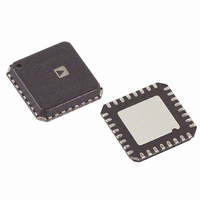AD9513BCPZ Analog Devices Inc, AD9513BCPZ Datasheet - Page 18

AD9513BCPZ
Manufacturer Part Number
AD9513BCPZ
Description
IC CLOCK DIST 3OUT PLL 32LFCSP
Manufacturer
Analog Devices Inc
Type
Fanout Buffer (Distribution), Dividerr
Datasheet
1.AD9513BCPZ.pdf
(28 pages)
Specifications of AD9513BCPZ
Number Of Circuits
1
Ratio - Input:output
1:3
Differential - Input:output
Yes/Yes
Input
Differential
Output
CMOS, LVDS
Frequency - Max
800MHz
Voltage - Supply
3.135 V ~ 3.465 V
Operating Temperature
-40°C ~ 85°C
Mounting Type
Surface Mount
Package / Case
32-LFCSP
Frequency-max
800MHz
No. Of Multipliers / Dividers
3
No. Of Amplifiers
4
Supply Voltage Range
3.135V To 3.465V
Slew Rate
1V/ns
Operating Temperature Range
-40°C To +85°C
Digital Ic Case Style
LFCSP
Package
32LFCSP EP
Lead Free Status / RoHS Status
Lead free / RoHS Compliant
For Use With
AD9513/PCBZ - BOARD EVAL CLOCK 3CH AD9513
Lead Free Status / RoHS Status
Lead free / RoHS Compliant, Lead free / RoHS Compliant
Available stocks
Company
Part Number
Manufacturer
Quantity
Price
Company:
Part Number:
AD9513BCPZ
Manufacturer:
ADI
Quantity:
3 000
Company:
Part Number:
AD9513BCPZ
Manufacturer:
ADI
Quantity:
140
Company:
Part Number:
AD9513BCPZ-REEL7
Manufacturer:
AD
Quantity:
1 000
Company:
Part Number:
AD9513BCPZ-REEL7
Manufacturer:
ADI
Quantity:
3 000
Part Number:
AD9513BCPZ-REEL7
Manufacturer:
ADI/亚德诺
Quantity:
20 000
AD9513
Synchronization is initiated by pulling the SYNCB pin low for a
minimum of 5 ns. The input clock does not have to be present
at the time the command is issued. The synchronization occurs
after four input clock cycles.
The synchronization applies to clock outputs
•
•
An output with its divider set to divide = 1 (divider bypassed)
is always synchronized with the input clock, with a propagation
delay.
The SYNCB pin must be pulled up for normal operation. Do
not let the SYNCB pin float.
RSET RESISTOR
The internal bias currents of the AD9513 are set by the
R
the value given as a condition in the Specifications section
(R
be readily obtainable. The bias currents set by this resistor
determine the logic levels and operating conditions of the
internal blocks of the AD9513. The performance figures given
in the Specifications section assume that this resistor value is
used for R
VREF
The VREF pin provides a voltage level of ⅔ V
one of the four logic levels used by the setup pins (S0 to S10).
These pins set the operation of the AD9513. The VREF pin
provides sufficient drive capability to drive as many of the setup
pins as necessary, up to all on a single part. The VREF pin
should be used for no other purpose.
SETUP CONFIGURATION
The specific operation of the AD9513 is set by the logic levels
applied to the setup pins (S10 to S0). These pins use four-state
logic. The logic levels used are V
⅔ V
each of the setup pins (S10 to S0). This is the level seen by a
setup pin that is left not connected (NC). The ⅔ V
provided by the VREF pin. All setup pins requiring the ⅔V
level must be tied to the VREF pin.
SET
SET
S
resistor. This resistor should be as close as possible to
that are not turned OFF
where the divider is not divide = 1 (divider bypassed)
. The ⅓ V
= 4.12 kΩ). This is a standard 1% resistor value and should
SET
Figure 23. Setup Pin (S0 to S10) Equivalent Circuit
.
S
level is provided by the internal self-biasing on
SETUP PIN
S0 TO S10
60kΩ
30kΩ
S
and GND, plus ⅓ V
V
S
S
. This voltage is
S
level is
S
and
S
Rev. 0 | Page 18 of 28
The AD9513 operation is determined by the combination of
logic levels present at the setup pins. The setup configurations
for the AD9513 are shown in Table 11 to Table 16. The four
logic levels are referred to as 0, ⅓, ⅔, and 1. These numbers
represent the fraction of the V
levels. See the setup pin thresholds in Table 6.
The meaning of some of the pin settings is changed by the
settings of other pins. For example, S0 determines whether S3,
and S4 sets OUT2 delay (S0 ≠ 0) or OUT2 phase (S0 = 0).
S2 indicates which outputs are in use, as shown in Table 10. This
allows the same pins (S5 and S6, S7 and S8) to determine the
settings for two different outputs, depending on which outputs
are in use.
Table 10. S2 Indicates Which Outputs Are in Use
S2
0
1/3
2/3
1
The fine delay values set by S3 and S4 (when the delay is being
used, S0 ≠ 0) are fractions of the full-scale delay. Note that the
longest setting is 15/16 of full scale. The full-scale delay times
are given in Table 3. To determine the actual delay, take the
fraction corresponding to the fine delay setting and multiply by
the full-scale value set by Table 3 corresponding to the S0 value
and add the LVDS or CMOS propagation delay time (see Table 3).
The full-scale delay times shown in Table 11, and referred to
elsewhere, are nominal time values.
The value at S2 also determines whether S5 and S6 set OUT2
divide (S2 ≠ 0) or OUT1 phase (S2 = 0). In addition, S2
determines whether S7 and S8 set OUT1 divide (S2 ≠ 1) or
OUT2 phase (S2 = 1 and S0 ≠ 0). In addition, the value of S2
determines whether S9 and S10 set OUT0 divide (S2 ≠ 2/3) or
OUT2 divide (S2 = 2/3).
Outputs
OUT2 Off
All Outputs On
OUT0 Off
OUT1 Off
S
voltage that defines the logic














